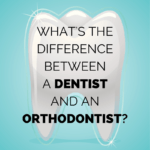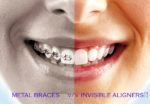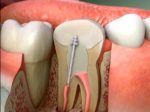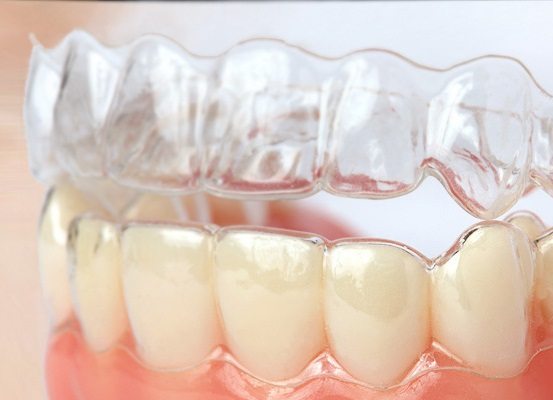 You’ve probably heard of Invisalign therapy before – and you may even know a little about it. Invisalign is a system of clear aligners that straightens your teeth just like braces would – but without all the awful metal brackets and wires. It’s a revolutionary technology and the most noteworthy innovation in orthodontics in decades.
You’ve probably heard of Invisalign therapy before – and you may even know a little about it. Invisalign is a system of clear aligners that straightens your teeth just like braces would – but without all the awful metal brackets and wires. It’s a revolutionary technology and the most noteworthy innovation in orthodontics in decades.
What does it meant to you as a dental patient? Many people would love to straighten their teeth so they look better, but it’s expensive for a cosmetic procedure. After all, everyone has a long list of expenses that take priority over those nice-to-have things.
Most people know that Invisalign clear aligners can help your smile “look” better – but not many people know that straightening your teeth can have significant benefits to your overall dental health. It can even help you keep your own teeth for life! This puts the cost investment in a different light when you understand that moving your teeth to a healthier position can actually help you avoid other costly and painful dental work in the future.

The best dentistry is preventative dentistry, and Invisalign treatment is no exception. You may have heard your dentist say, “Do this now so we don’t have to do something bigger and more costly later on.” It’s a cornerstone of good dentistry to catch problems in the early stages so they don’t become worse.
Invisalign therapy is one of the best preventative treatments available. Not every dentist is trained in treating patients with Invisalign, so you can benefit from seeking out a dentist who is well-versed in this modern preventative technology.
What Dental Problems Does Invisalign Prevent?
 When your teeth are in an unhealthy position – known as “malocclusion” – they can damage each other in a variety of ways. As we age, nearly everyone experiences shifting of their teeth. Most of the time, the teeth shift forward in the mouth, and they tend to get more crowded – especially your bottom teeth. Even when people have had braces as teenagers, many stop wearing their retainers and start to relapse to the old position.
When your teeth are in an unhealthy position – known as “malocclusion” – they can damage each other in a variety of ways. As we age, nearly everyone experiences shifting of their teeth. Most of the time, the teeth shift forward in the mouth, and they tend to get more crowded – especially your bottom teeth. Even when people have had braces as teenagers, many stop wearing their retainers and start to relapse to the old position.
When the teeth become crowded and overlapped, it becomes harder to clean them properly. This creates plaque and tarter build up over time in those crowded areas. On a microscopic level, this actually houses the most harmful type of bacteria in our gums in those crowded areas. So not only can we not clean properly, we also create the perfect environment to breed dangerous pathogens within our gums. This can cause chronic gum infection known as “periodontal disease.”
Our gums are like sponges, and bacteria that is present there goes right into our blood stream. This has been linked to other systemic disease such as heart disease and diabetes. You may notice that now even your regular Medical Doctor will ask you if you get your teeth cleaned regularly – as it’s widely proven medical knowledge that our dental health can have an influence on our overall health.

In addition to the damage to our gums, badly positioned teeth can also cause damage to each other. Think about it. Every day you eat food, and your top and bottom teeth are banging together. If you get stressed, you may even grind your teeth. If your teeth are in a bad position while they’re hitting each other, it’s going to cause abnormal trauma and wear over time. This means that your teeth might chip and crack due to these unhealthy forces. Moving your teeth to the correct position can help protect them from this kind of damage.
Many dentists have basic training in Invisalign, but not everyone has extensive experience. Surprisingly, Invisalign therapy isn’t the same in every doctor’s hands – it’s a highly technique sensitive product and the skill level of the dentist treating you has everything to do with the overall success of your treatment. It’s important to seek out a provider who is proficient with the product.
How Does Invisalign Work?
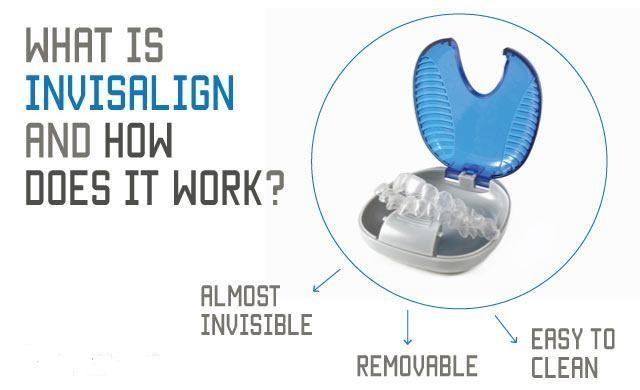 Now that you know how Invisalign treatment can benefit your dental health, let’s review what treatment is like. After you’ve decided you want to pursue treatment with your dentist, the next step is to take your records. You’ll have a panel of intraoral photos taken, and either a physical impression of your teeth or in many cases a digital scan.
Now that you know how Invisalign treatment can benefit your dental health, let’s review what treatment is like. After you’ve decided you want to pursue treatment with your dentist, the next step is to take your records. You’ll have a panel of intraoral photos taken, and either a physical impression of your teeth or in many cases a digital scan.
These records are sent to Align Technology, maker of Invisalign. Align develops a 3-D software treatment plan, and your doctor customizes this treatment plan. This is why it’s so important to be treated by a dentist with solid experience – the treatment plan is critical to a successful outcome, and it takes specialized knowledge to develop the perfect treatment plan.
After the doctor is satisfied with the treatment plan, your aligners are manufactured and sent back to your dentist. This process take about 3-4 weeks in most offices.
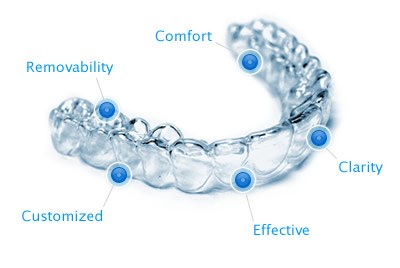 Then you’ll return to the office for your 1st set of aligners. Sometimes the dentist will add your attachments right away, other times you’ll get them at a later appointment. Attachments are tiny tooth colored bumps that are bonded directly to your teeth. The grip onto the aligners and help facilitate certain movements. They may be slightly visible, but typically they are small and unobtrusive.
Then you’ll return to the office for your 1st set of aligners. Sometimes the dentist will add your attachments right away, other times you’ll get them at a later appointment. Attachments are tiny tooth colored bumps that are bonded directly to your teeth. The grip onto the aligners and help facilitate certain movements. They may be slightly visible, but typically they are small and unobtrusive.
The dentist will usually give you 4-8 aligners at a time, and you’ll change these every 1-2 weeks on your own. You’ll return for quick check-in appointments every 6-12 weeks to ensure your treatment is progressing. The most important thing is to wear your aligners all the time – the only way you’ll get through treatment on-time is by being diligent with wearing them. If you slack off, you’ll be very frustrated and prolong your treatment significantly. It’s important to know this going into it and be ready to do your part.
At the end of your run of aligners, the dentist will evaluate your teeth and may opt for a final detailing set of aligners to fully finish your case. After that, you’ll be fitted with retainers that you may wear full-time initially, and then step down to part-time. It’s important to note that you need to be prepared to wear your retainers at least a few nights a week for the rest of your life to ensure that your teeth stay in their new healthy position.
Why Should A Dentist Provide Invisalign Therapy?
General dentists are tasked with providing a wide range of services today. What is the benefit of integrating Invisalign clear aligners into a general dentistry practice?
 The most important benefit is the ability to provide better and more comprehensive care to patients. Invisalign treatment is one of the best preventative, non-invasive therapies to help patients keep their teeth for a lifetime.
The most important benefit is the ability to provide better and more comprehensive care to patients. Invisalign treatment is one of the best preventative, non-invasive therapies to help patients keep their teeth for a lifetime.
If you’re a general dentist who’s trained in Invisalign treatment, it’s critical routinely treat cases to keep your skills well-honed. Just like any procedure, the more you do, the better you get at it. It’s also important to understand appropriate boundaries for case selection, and maintain a working relationship with an orthodontist to send them the tougher cases – just as you work with other specialists.
Integrating Invisalign therapy into your daily routine takes your whole team supporting the effort in order to be successful. Your hygienists need to be diagnosing malocclusion. As the doctor, you need to believe in the health benefits of straighter teeth and effectively communicate them to patients. Your assistants need to be proficient in monitoring and troubleshooting cases. And your front office team needs to be adept at workable financial solutions that are comfortable for patients.
The best part? All of these team capabilities will help your practice run more smoothly overall across your daily procedures.
Lastly, patient satisfaction is extremely high with Invisalign therapy – patients are usually thrilled with their new, beautiful smile and feel the better functionality of their teeth. Happy patients are the best marketing for your practice!


